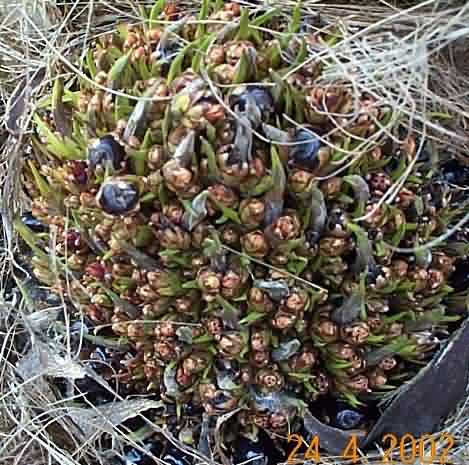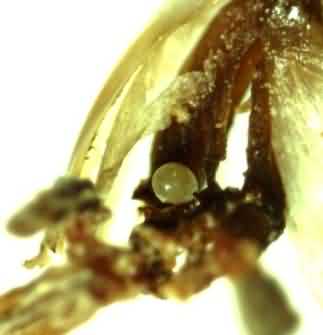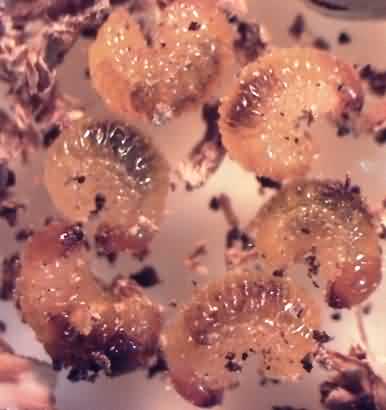तेल पाम में परागण करने वाला एक घुन या कीट- भुजा एलाइडोबियस कामरुनिकस (फ़ॉस्ट)
Oil palm, Elaeis guineensis Jacq. is a monoecious plant which means it bears male and female inflorescences, separated from one another on the same vegetative axis. This particular situation demands cross pollination, as both the inflorescences of the same plant are seldom simultaneously receptive.
Pollination in oil palm is primarily by various means viz., wind and insects. Several species of insects are reported as natural pollinating agents, of which Elaeidobius kamerunicus is the predominant species.
Introduction of this weevil increased fruit set from 36.9 to 56.0% resulting in 40% increase in bunch weight. Knowing about various aspects of pollinating weevil, will assist oil palm growers to plan the plant protection strategies and conserve the pollinating weevils for better performance in pollination.
Bunch failure and Insect pollination in oil palm
Bunch failure refers to bunch that fails to develop from anthesis to harvest. This could be due to physiological reasons, bunch rot, poor pollination (lack of pollinators) etc.
Figure 1. Oil palm with adequately pollinated fruit bunches Figure 2. Bunch showing very poor fruit set
Anthesis of male flowers (refers to stage of pollen production) starts with the opening of florets at the base of the male inflorescence. The opening progresses gradually upwards until all the florets on the spikelets are opened in about three days.
The weevils only start to visit when florets begin to open at the base. The weevil number increases rapidly on the second and third day of anthesis and then declines from the fourth day. Very few are found by the sixth day.
The male flowers at anthesis emit a strong aniseed odour to attract weevils. The weevils are also attracted to female inflorescences during anthesis (refers to receptivity of flower). The receptivity normally lasts for about 2 to 3 days.
The adults of the weevil are attracted to female flowers by their odour , which is similar to that of a male inflorescence, but they soon fly away.
The weevils arrive on the female inflorescence carry pollen adhered all over its body and transfer them to the stigma of the female flowers when they are receptive. However, they do not cause any injury.
Even the inner flowers on the spikelet are also pollinated, thus ensuring fully fertilized fruit lets with well developed kernel and embryo.
Figure 3. Receptive female flower Figure 4. Pollinated female flower Figure.5. Male inflorescence with congregating pollinating weevils
In young and isolated plantations, pollination is usually inadequate because there are fewer male inflorescences. Male inflorescences alone are the feeding and breeding sites for weevils. Pollen dispersal by wind is limited since, the low canopy of young plantation acts as a barrier to free air movement.
With poor pollination, the fruit bunches are also not well developed because the fruits are either parthenocarpic (much smaller fruits without kernel), partially aborted or rotten.
In general pollination may not be problem in aged oil palm plantations, as the sex ratio decline from 90 percent (young plantation) to about 50 percent as the palms grow older. Moreover, taller palms facilitate wind pollination.

Figure.6. Adequately pollinated fruit bunch
Development and feeding of the weevil
Elaeidobius kamerunicus (Faust.) is a small weevil belonging to the order Coleoptera of the family Curculionidae. The life cycle of the weevil is totally dependent on the male inflorescences of the oil palm.
Eggs are laid in a feeding pit on the corolla of flowers. The eggs are whitish, oval with a smooth, delicate chorion. Usually one egg is found in one flower but sometimes two eggs are also seen. Each female weevil on an average lays 35 eggs during its life time.
The egg hatches within a day or two and the first larval instar feeds on the inner tissue of filament of male flowers. There are altogether three larval instars. The second instar moves to the base of the flower, where feeding on the soft tissue is resumed.
The egg and the first two larval stages are completed in three days. The third instar larva feed voraciously and consume from the base of anther tube upwards until upper dried part is left.
Once the flower is consumed the larva cut a hole through the hard perianth near the base of the adjacent flower resuming feeding from the base upwards. In this way the third instar larva may consume 5 to 6 flowers in 5 to 8 days of life.
Pupation takes place in the consumed flower and it lasts for 3 days. Thus the egg to adult emergence period is completed within a period of 11 – 14 days, but sometimes as long as 20 days. They feed and breed only on male inflorescences after the flowers have released pollen and started decomposing.
The adults chew anther filaments or anther tubes of opened flowers. This insect is host specific and develop only on oil palm.
Figure 7. Egg Figure 8. Grubs Figure 9. Pupa of Elaeidobius kamerunicus


Figure.10. Female pollinating weevil Figure.11. Male pollinating weevil
Effect of abiotic factors on weevil activity
Though the weevils are established itself well in most of the oil palm plantations in India, but the population fluctuates between the seasons reaching its lowest level during summer month (April, May, June). The wet season (July, August, September) is more favourable for the population build up. The activity is drastically reduced or absent during severe summer months, especially in some of the young plantations. However, they start building up as soon as weather conditions are conducive.

Figure.12. Male inflorescence (during anthesis) without pollinating weevil during summer months
Adverse biotic factors on weevil
Under field conditions, earwig, Chelisoches morio is found harbouring on male inflorescences and prey on the immature stages of the weevils. Similarly, the garden lizard, Calotes versicolor catch and eat weevils using its sticky tongue. It is normally seen on anthesising male inflorescences on which pollinating weevils congregate in large numbers. During the dry seasons, reduvid bugs, Sycanus sp. play avital role in reducing the number of weevils. In addition to this, weevils emerging from the spent inflorescences that are attracted and coming towards the anthesising male and female inflorescences are trapped in spider webs and are fed by the different species of spiders.These are of great concern especially during summer months as the weevil population is already less.

Figure.13. Spider webs with trapped pollinating weevils
Important management tips to remember for conservation
1. Owing to increasing insect pest problems, the farmers are provoked to take up control measures by using synthetic insecticides like monocrotophos, quinolphos, lambda cyhalothrin, etc. When these chemicals are sprayed indiscriminately, mortality of the weevils is observed resulting in poor pollination. Hence the criteria for timing and mode of application of insecticides in the oil palm gardens will be useful in conserving this weevil. For instance,
- The adult weevils activity is more between 9.30 AM to 1.00 PM. Therefore, scheduling chemical sprays at afternoon hours will facilitate to avoid direct contact of pesticide particles on flying weevils in the garden.
- Insecticides like monocrotophos and imidacloprid can be administered through stem injection method instead of direct spraying.
- Avoid directing the sprayer nozzle towards the crown region of the palm, especially on male and female inflorescences while spraying as it causes severe mortality.
2. Adult weevils normally emerge from spent male inflorescences from 11 to 20 days after the first day of anthesis. Hence, while cleaning the crown region care must be taken for not removing the inflorescences which are of less than 20 days old (after the first day of anthesis).
3. Weevils emerge from the spent inflorescences get trapped in spider webs present around in the crown region. Hence, care must be taken in conserving the weevils and to facilitate free activity.
4. Pollinating weevils should be introduced to newly planted oil palm gardens as soon as they attain 3 years. Spent spikelets having developmental stages (larva and pupa) are to be collected from nearby already established gardens and place them in the new gardens for the establishment. This is to be done at regular interval until weevil establishment is seen.
Authors:
L.Saravanan, P.Kalidas, T.Phanikumar and K.Ravi Babu
Scientist (Ag.Entomology), Directorate of Oil Palm Research,
Pedavegi-534 450, West Godavari (Dt.) Andhra Pradesh
Email:








